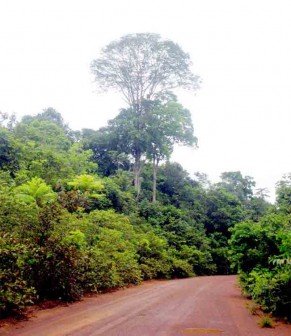Purpleheart (Peltogyne venosa) belongs to the family of Caesalpiniaceae. The species is found growing in sandy plains and terraces and it is distributed throughout Central and South America from Mexico down to southern Brazil; in other parts of the world it is referred to as Amaranth and Violetwood. Purpleheart ranges in height between 30m – 50m with a moderate buttress and a trunk greater than 1.5m. It has a straight cylindrical bole ranging between 20m – 30m and is one of the emergent species of the rainforest, easily recognised standing above the forest canopy exhibiting an almost perfect mushroom shaped crown.
![]() Purpleheart trees are leguminous and thus fix nitrogen in the soil, making it an important species for maintaining soil quality and richness. Purpleheart has alternating leaves, divided into a symmetrical pair of large leaflet between 5cm -10cm long and 2cm – 4cm broad. The flowers are small with five white petals produced in panicleswhile fruits are produced in a pod with a single seed. This species is well known for the unique colour of its wood; when freshly cut the wood is a dull grayish-purplish brown but with continued exposure to air, deepens to an eggplant purple. Further exposure to UV light degrades the hue to a dark brown with a hint of purple. This decay of colour can be slowed by using a UV inhibiting finish.
Purpleheart trees are leguminous and thus fix nitrogen in the soil, making it an important species for maintaining soil quality and richness. Purpleheart has alternating leaves, divided into a symmetrical pair of large leaflet between 5cm -10cm long and 2cm – 4cm broad. The flowers are small with five white petals produced in panicleswhile fruits are produced in a pod with a single seed. This species is well known for the unique colour of its wood; when freshly cut the wood is a dull grayish-purplish brown but with continued exposure to air, deepens to an eggplant purple. Further exposure to UV light degrades the hue to a dark brown with a hint of purple. This decay of colour can be slowed by using a UV inhibiting finish.

Purpleheart is an extremely hard wood thus making it a bit difficult to work with, however it is rated for being very durable and resistant to both decay and most insect attacks and its resistance to acidity makes it useful in construction of chemical vats. Regardless of density, its exquisite colour causes it to be sought after for speciality uses including sculptures, carvings, ship building, flooring, trims, inlays and accents. As an exotic species Purpleheart carries a moderate price on the international market and the species has been heavily exploited for its qualities and is becoming increasingly rare.
“Rain forests are rich in biodiversity and are home to many different plants and animals as well as indigenous communities. Humans, even those who don’t live in the rain forest, rely on it for resources such as building materials (wood and lianas), medicine and fruits. Rain forests also provide essential environmental services for life on earth; they create soil as well as prevent soil erosion, produce oxygen though photosynthesis, maintain clean water systems, and are a key defence against climate change.
The Iwokrama Rain Forest is 371,000 hectares, located in the heart of Guyana. Our mission is to develop strategies for conservation and sustainable development for local people in Guyana and the world at large. We are involved in timber, tourism and training. Come and visit us in the rain forest or at http://www. iwokrama.org.









